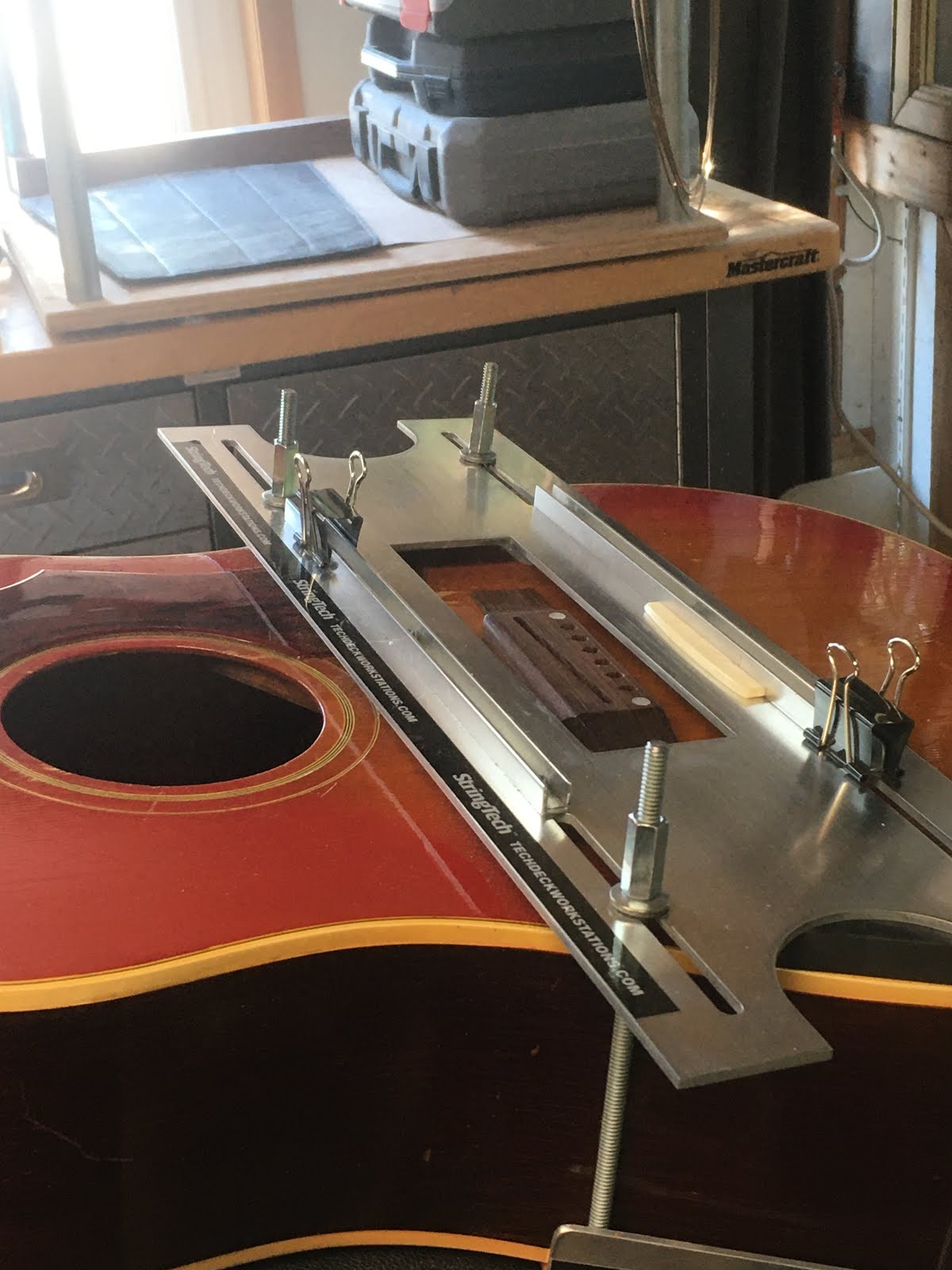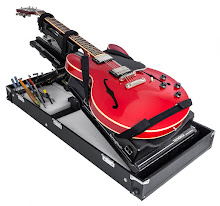Gibson ES-335's x 3
I hadn't seen a 335', for a couple of months ...
and then 3 of them had shown up on the same day !
 Fret Dress / Edge Dress Demo
Video Link:
Fret Dress / Edge Dress Demo
Video Link:
Guitar Repair and Design
The TechDeck's design,
function and versatility, eliminate the
the need for vices, dial callipers
arbour presses, vice grips,
or computer controlled
fret dressing machines.
All of your fret-work needs
in one multi-adjustable package.
Fret work and fret dressing
just got a whole lot easier.
Fret Dress Video Link:
Al Maynard's reaction ....
after receiving his TechDeck
March 24th 2014
Thanks Brother ... love it.
"My shop's production has tripled."
This is one Gem of a Tool !
Great addition to repair the museum pieces ,
Fenders, Gibsons and Martins are all happy.
Regards,
Al Maynard
Windsor, Nova Scotia
Canada
Pro Guitar Tech
Hi Michael,
The Techdeck was a 60th birthday gift for me.
I am a home guitar hobbyist and collector.
I’m a machinist / millwright by trade,
so I recognise the genius behind your creation.
Best regards,
Colin
Sherwood Park
Alberta, Canada
TechDeck Order / Purchasing
info@techdeckworkstations.com
The following accessories are available for all TechDecks:
Mini Neck Assembly $87.50
Extra V-Block $17.50
Bridge Slotting Jig $187.50
Neck Surgery Kit $265.00
For International Customers:
Shipping the BSJ in the TechDeck carton,
can amount to quite a significant
savings in shipping costs.
Two of these 335's were set up with a CNC machine.
Please read on so that I may clarify. The other one ( Black dot-neck )
is an instrument that I have maintained since it was purchased new.
It has never seen a "CNC fret dressing machine".
I corrected, what the ( supposedly "infallible" )
CNC machine ... quite obviously missed,
on 2 of these 335's.
I suppose that the machine is only as good as the operator.
I felt compelled to point this out, after reading in a forum that
"no Luthier could possibly do a job as accurate as the CNC machine ".
With all due respect to the CNC people ...
I beg to differ ....
I've read, that in a production setup,
when doing the same model of guitar over and over,
that the CNC machine works quite well.
I can see that; once the machine has been setup and calibrated,
by a trained and competent operator.
The TechDeck pricing
( with all the accessories )
comes in at less than 1% of the cost
of these CNC fret dressing Machines :^ )
Realistically; for the average Luthier /Tech,
Pro-Shop, Music store, High School Music Department or
Guitar enthusiast with a collection of various guitars;
who are changing from a mandolin to a Flying "V",
to a banjo to an arch-top guitar
to a bowl back Ovation guitar etc ..
over the course of an afternoon's work;
the change-over time from instrument to instrument
for the TechDeck is
an average of about 30 seconds or less.
Hello Michael,
Long time, no chat. I hope all goes well in beautiful Stratford.
I have been using my TechDeck regularly since I got it from you. I know you've heard this before, but I really don't know how I got along without it. It just makes everything so much easier.
Best regards from Ottawa. ( May 2015 )
Murray
( Murray Jackson .... bought his TechDeck in November 2011 )
Thanks for a great product and exemplary service !
R.L. Burns ( Las Vegas , Nevada )
The real question that begs to be answered ,
is not whether the astronomically expensive
CNC machines (originally selling for $100,000 ++ !! )
does its job or not.
Although the fret dress is definitely the "cash-cow" job for the TechDeck;
it is just one of 100's of operations performed :^) !
I've stood back and smiled, and shook my head,
as the industry has gone around and around,
chasing it's tail over the last decade ...
trying to find a solution ... spending scads of cash;
while I calmly show total beginners how
to do flawless fretwork on the TechDeck,
after an hour of training.
All of this time and money
has been invested by the Guitar Industry,
in the hopes of getting rid of
the common buzzing problems
that prevent most guitars
from being set up with
a nice close action.
I've added these
current jobs, to illustrate
that all of these brand new guitars,
were desperately in need
of fret levelling and re-crowning.
Gibson Les Paul
Slash Model
Epiphone 339"
New Gretsch
Schecter
All of the above guitars, Gibson LP Slash , Epi 339' /
Schecter / Gretsch ; changed from being
"barely worth playing " to "Playing smooth as Silk "
as these TechDeck Owners
finished levelling / re-crowning and
polishing the frets, to perfection.
Hi Michael,
Thanks for the video link,
The TechDeck arrived yesterday, and I am very impressed with it already!
I put it to work straight away with a fret level and dress on a locally (factory) made Maton 325 dreadnought.
after a couple of views of the video I had it all set up with the guitar secured and the neck well supported, the level and dress came out perfect.
the job went very smoothly with so much less effort to level, crown and polish with the guitar so well held and supported.
the customer picked up his guitar today and was very pleased with the set up.
I will be adding a new bench for the techdeck and setting up a designated repair area very soon, so will send you a pic when it is all set up.
No more putting away the guitar I'm building to repair or inspect a customers guitar.
Thanks for designing such a great tool, I think it will be invaluable to my business.
Regards,
Daniel Hoban
Both the Red 335" and the
brand new Tobacco Sunbusrt 335',
were completed in a fraction of the time
and at a fraction of the cost
of the typical "Plek" charge.
Great construction, feels good and solid, its the most exciting thing I've had delivered for a good while :)
I'm going to do a few fret dresses with it and get fully used to it then crack on with the scrapper neck repairs - then the real deals.
Stupidly excited about this, feels like the start of a new era in here!!
ps Thanks for these emails, I totally appreciate how much effort it is to stop and document this stuff. I'll have them to read back through again; and walk me through it - so cool to have this resource!
The confusion and misinformation regarding
very common fret issues, tells me that
"common sense is often in short supply"
when it comes to basic guitar physics.
I felt compelled to speak up in defense
of all good Techs and Luthiers and
to set the record straight.
Please read on ..
I've added this job,
to let everyone know that all
of the TechDeckers out there
... are still at it ...
addressing these fret issues daily,
with a minimum amount of fuss,
and with consistent accuracy and safety.
After a fret dress / crown / polish /
I corrected ... once again .... what the
Plek machine missed;
and buffed these frets to a mirror finish.
These jobs are accomplished on a daily basis,
without the use of steel rods up the back of the neck,
vices / clamps, computer programs, CNC machines
vice grips, dial calliper posts, or arbour presses.
There are 2 main issues
that need to be addressed when
leveling fingerboards and frets.
#1: The instrument, both body and neck ,
needs to be held firmly and safely;
to resist the tooling force of the
levelling blocks or mill files
as you do your work.
#2: Once you have straightened the lay of the neck
( when working on instruments with adjustable truss rods ),
in preparation for levelling;
it is imperative that you completely
restrict the "flex" of the neck,
along it's entire length
The TechDeck, by design,
addresses both of these
critical requirements
quickly, safely,
and consistently.
With the TechDeck; the body of the guitar
is strapped down firmly to the leather padded rails
of the adjustable body-platform.
The leather straps are then "cinched"
firmly enough to completely immobilise the body
( any size .. any shape ) of the guitar,
so that the instrument does not shift or wobble,
as you perform your work.
The telescopically adjustable neck support,
slides into position in a couple of seconds.
The sliding V-blocks are then quickly
adjusted for the length of neck.
The neck support pivots,
naturally finding it's centre.
This prevents the neck from "flexing"
while you are "leaning into" the files
or leveling blocks to true-up the fingerboard
or when dressing and levelling frets.
The TechDeck also addresses
these same issues of stability / safety / accuracy
when levelling or putting the radius
on a guitar, mandolin, Cello,
Violin or Upright Bass fingerboard.
The TechDeck has a
footprint of 2.2 square feet.
This 2.2 square feet,
that the TechDeck needs;
instantly becomes
the most valuable real estate
in your shop.
The TechDeck will switch fret work
from being your worst nightmare,
into being your best friend.
Offer a super deal for your
customers, and still
make a
very respectable wage for yourself !
I work outside, in the shade of the honey locust tree,
during the summer months !
The Fret Dress is just one of dozens of tasks
that are performed on the
TechDeck every month.
I installed this Callahan SS bridge,
tailpiece threaded inserts,
and extended SS bridge posts
before dressing the frets and
installing a compensated nut
on "Racin' Ronny's" Red Demon.
He's pluggin' this into a
Vintage Super Reverb !! .... Rippin' !!
Another interesting note ..... all three
of these customers each own
a Tele, a Strat and a 335 !!
Great minds ( and rippin' guitar players ) think alike.
Touche' !

Stainless Steel Extended bridge posts









































































